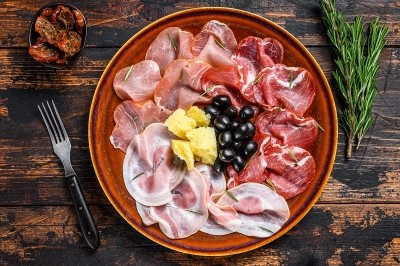Cultivated, cultured, or other? Making alt meat terminology appealing and transparent

What’s in a name? Well, quite a lot in the slaughter-free meat scene. Especially if you’ve spent years developing your product from animal cells, have attracted millions in investment, and know that once approved by regulators, your product’s success will rely on consumer uptake.
Since the concept of cell-based meat was first introduced to wider audiences in the early 2000s, and even more so since the first cultivated beef burger patty was created in 2013, a number of different terms have been used to describe the product.
These include in vitro, synthetic, lab-grown, cell-based, cultivated and cultured, amongst others.
Now that the first cultured meat product is on the market (Eat Just’s cultivated chicken ingredient in Singapore), companies and academics alike are increasingly turning their attention to the consumer: which terminology will best whet shoppers’ appetites for lab-grown products?
A brief history of bovine
Over the years, industry has considered a number of different terms for cell-based beef, as well as other species developed from animal cells in bioreactors.
Amongst the first was ‘in vitro’, Christopher Bryant, researcher from the University of Bath, recalled at FoodNavigator’s Climate Smart Food event. This term hasn’t hung around. “Someone correctly decided that perhaps that didn’t sound the most appetising,” he told delegates at the event.
From there, the term ‘cultured’ meat entered the mainstream, before terms like ‘clean’ meat and ‘craft’ meat were used in the space. “They tended to do quite well in terms of consumer scoring,” recalled the social psychologist. “Although it wasn’t necessarily clear from those names what the products were actually meant to be.
“There could be some other kinds of confusions or conflicts in the industry as well.”
As ‘cultured’ is still used by many, it is likely to be the longest existing term for these products. However, Bryant suggested he preferred another popular term: ‘cultivated’.
“I think ‘cultivated’ is a nice term. It performs very similarly to ‘cultured’ in terms of consumer polling, but the real advantage is that it links in with other terminology that can be used with respect to this technology.”
For example, it can be used as a verb: ‘we’re cultivating meat’. It can also be used to reference equipment in the space, such as using the term ‘cultivators’, instead of bioreactors.
Cultivated vs cultured
At Climate Smart Food, an event attended by industry professionals, we asked the audience which term they preferred to describe alt meat made from cells: cultivated, cultured, lab-grown, or cell-based.
Results from delegate votes revealed the preferred term was cultured meat (45%). Cultivated meat was the next most popular at 30%, followed by cell-based (16%) and lab-grown (8%).
As ‘cultivated’ appears to be the increasingly preferred term by cell-based meat start-ups (Aleph Farms, Mzansi Meat Co., and Gourmey are among the players using this terminology), we asked the industry whether such findings were surprising.
“I am not surprised,” Nicolas Morin-Forest, CEO and co-founder of cell-based poultry start-up Gourmey, told the event, “but my personal preference is for cultivated”.
For Gourmey, which is working on a flagship product of slaughter-free, ‘ethical’ foie-gras, ‘cultivated’ is less ambiguous. “I think ‘cultured’ could be a bit less clear than cultivated, in the sense that it’s already used for certain categories of products.”
In dairy, for example, products such as cultured butter and cultured cream are both popular in Europe.
“So consumers are not necessarily going to associate the word cultured, and truly understand [its meaning].”
‘Cultivated’, on the other hand, is a newer term, and consequently can serve to ‘shape the category’, Gourmey’s CEO elaborated. Not only is the term likely to be less ambiguous, but it is ‘still quite positive’, and not as ‘discouraging’ as ‘lab-grown’, we were told.
Bath University’s Bryant agreed, telling delegates the term ‘probably cuts down on some amount of confusion’, as cultured is used in other contexts.
London-based cultivated fat operation Hoxton Farms, a B2B start-up looking to market to plant-based meat manufacturers, echoed Gourmey’s view.
“’Cultivated’ is a term I like for similar reasons. I don’t have a strong aversion to ‘cultured’, but it has been used for other products in food, so it’s not my favourite,” said Hoxton Farms’ co-founder Ed Steele.
The case for transparent labelling
Another concern in how these products are marketed and labelled lies in transparency. Consumers will not only need to understand that the product was made from animal cells, but specifically from which animal the cells derived.
“We will need to call these products by the name of the species from which [the cells] come from,” explained Gourmey’s Morin-Forest. “If you are eating a cultivated duck product, as is the case for our cultivated foie gras, you’ll need to know that you are consuming duck proteins.”
This is not only important for transparency but crucial for consumers with animal protein allergies.
Shellfish allergy is one of the most common food allergies, for example. “You need to know that if you are eating cultivated shrimp, for instance, that you are eating shrimp proteins,” Morin-Forest reiterated.
Aside from allergy concerns, Gourmey also wants to make sure consumers know they are not consuming conventional meat.
“We don’t want to mislead the consumer and make them believe they are buying conventionally produced meat. We want them to know and for them to support…this category of product.”
The answer could well lie in combining traditional terminology, such as the name of a particular species of animal, with new adjectives – such as ‘cultivated’. This will make it ‘really clear’ that it is duck, or shrimp, or beef, but produced in a very different way, the CEO continued.
Hoxton Farms’ Steele agreed naming the specific species is crucial, as is highlighting the method of production. “We want to celebrate that and know what species it is we’re eating.”
Missed Climate Smart Food? Don't worry, the four days of content is still available free on demand... Simply register HERE to catch up.



























